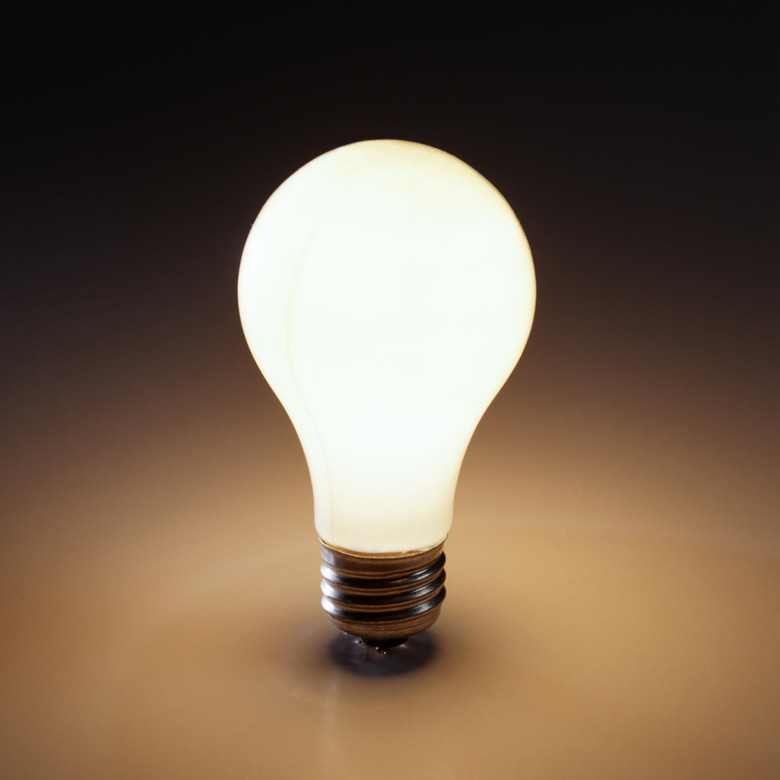How To Calculate Lumens Per Watt
If you're thinking about calculating lumens per watt, you're probably shopping for light bulbs. An easy way to understand these quantities in terms of light bulbs is to consider the number of watts as the energy input into the bulb and the number of lumens as the energy output. Just remember that it's an approximation, because lumens are actually units of brightness, not energy.
The number of lumens per watt is a characteristic of each light bulb and is a measure of the bulb's efficiency. It depends on a number of factors, including how the bulb makes light, the quality of the materials from which the bulb is made and how much of the input energy is wasted as heat. The packaging tells you the number of watts of power each bulb consumes and the number of lumens of light it puts out. The number of lumens per watt is simply the ratio of these two numbers.
What Is a Lumen?
What Is a Lumen?
Get ready for some scientific and mathematical jargon you may not have heard before. A lumen is defined in the SI (metric) measurement system as the amount of luminous flux emitted per second in a unit solid angle of one steradian by a source of one candela. A steradian is simply an area at a distance r from the source equal to a circle with area r2.
The unit originated in the days when candles provided all the light and luminosity was measured in foot-candles, which is still true in the lighting industry today. If you set a candle a foot away from a wall and draw a 1-foot square on the wall, the amount of light illuminating that square equals one lumen.
What Is a Watt?
What Is a Watt?
A watt is a unit of power in the SI system. In that system, work and energy are measured in joules, and because power is the rate of doing work, one watt is equal to one joule per second. The power in an electrical circuit, which is equal to the voltage across the circuit multiplied by the current, is also measured in watts.
The wattage of a light bulb is the amount of energy the bulb consumes, and it's what you end up paying for when your electrical bill comes. The energy does produce light, but you can't convert lumens to watts and back again because not all of the input energy goes into the production of light. The best you can do is form a ratio of lumens to watts, which is the luminous efficiency of the light bulb.
Compare Bulbs with a Watts to Lumens Chart
Compare Bulbs with a Watts to Lumens Chart
When you're shopping for light bulbs, you want to know how much light the bulb produces and how much energy it consumes. You'll find that information on the packaging. You can compare bulbs by consulting a watts to lumens chart, which you can find online or in any lighting store. When you do this, you might be surprised by how little energy CFL, LED and even halogen bulbs consume to give you the same amount of light as an incandescent bulb.
For example, a 100 W incandescent bulb produces about 1,600 lumens, for an efficiency of 1,600/100 = 16 lumens per watt. A halogen bulb, on the other hand, consumes only 72 watts for the same amount of brightness, making its efficiency 1,600/72 = 22 lumens per watt. A CFL bulb consumes even less energy – only 26 W – so its efficiency is 61 lumens per watt. Finally, LED bulbs, which are the most efficient, consume only 22 watts for an efficiency of 73 lumens per watt.
If you think about the equivalent lumen output, you would only need 22 W of power going to an LED light to match the performance of a 100 W incandescent bulb. This means LED lights cost roughly five times less to operate than incandescent bulbs.
Cite This Article
MLA
Deziel, Chris. "How To Calculate Lumens Per Watt" sciencing.com, https://www.sciencing.com/calculate-lumens-per-watt-4897086/. 22 July 2019.
APA
Deziel, Chris. (2019, July 22). How To Calculate Lumens Per Watt. sciencing.com. Retrieved from https://www.sciencing.com/calculate-lumens-per-watt-4897086/
Chicago
Deziel, Chris. How To Calculate Lumens Per Watt last modified March 24, 2022. https://www.sciencing.com/calculate-lumens-per-watt-4897086/
